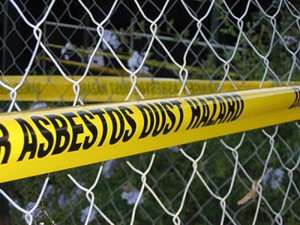Most small businesses will go for many years without having any cause to worry about working with or being responsible for the removal of asbestos, but occasionally it may arise and then it will be necessary to bring in a licensed remover because of lack of training in the workforce. The UKATA (United Kingdom Asbestos Training Association) training programmes are very easy to arrange through Boss Training and by keeping at least a core staff up to speed on how to assess, monitor and deal with asbestos would be good business practice for the smaller building contractor, especially one who occasionally undertakes work in older properties, built before the asbestos legislation currently in force was in place.
Dangers of Asbestos
 Asbestos fibres, if breathed in even over a short period can become embedded in the lungs and can, often many years later, cause a lung malignancy called pulmonary mesothelioma which is invariably fatal. The Health and Safety Executive has set the acceptable range of asbestos to a level at which the concentration in the air does not exceed 0.6 asbestos fibres/cm3 over 10 minutes and that the person’s exposure will be less than 0.1 fibres per cm3. Training in how to use the monitoring equipment is essential – as the figures show, the amounts which must be measured are small and unless the machinery is calibrated and maintained accurately, the measurements are worthless.
Asbestos fibres, if breathed in even over a short period can become embedded in the lungs and can, often many years later, cause a lung malignancy called pulmonary mesothelioma which is invariably fatal. The Health and Safety Executive has set the acceptable range of asbestos to a level at which the concentration in the air does not exceed 0.6 asbestos fibres/cm3 over 10 minutes and that the person’s exposure will be less than 0.1 fibres per cm3. Training in how to use the monitoring equipment is essential – as the figures show, the amounts which must be measured are small and unless the machinery is calibrated and maintained accurately, the measurements are worthless.
Risk Assessment Training
Perhaps more than any other factor in construction, risk assessment in whether to tackle asbestos yourself or call in the experts is essential and, like monitoring levels, it has to be got right first time. There is no turning the clock back after asbestos exposure, so there is no real room for error. The training will explain what likely scenarios are likely to pose little or no threat assuming safety precautions are taken, but there is always the one-off situation where the trained person must make a value judgement. A typical case which is unlikely to need specialist intervention is one in which it is necessary to drill holes into a wall known to contain asbestos. With correct dust suppression measures, adequate protective clothing and masking and full decontamination of the site, debris and clothing when the job is done, there should be no risk, but in the end it has to rest on the judgement of the person trained in safely dealing with asbestos.
Does Everyone Need Training?
This is one of the few cases where untrained people can work under the supervision of trained staff, but they must follow instructions to the letter, especially when it comes to the practical parts of the job such as dust suppression. The monitoring must take place throughout the job and this must be the remit of someone who is fully trained in the use and understanding of the meter. Adequate records must also be kept and this is also a job for someone who is fully trained. The records must be kept safely to be referred to at a later date, because one of the problems with dealing with asbestos is that health issues may not actually present themselves until many years after the inhalation event. Mesothelioma used to be relatively common when whole buildings were sometimes built from asbestos and some people were unfortunate enough to have many years exposure. Although it is now very rare, it does still occasionally occur but with good training and management, cases of mesothelioma caused by industrial asbestos inhalation could be eradicated completely.
Should Managers Be Trained?
A manager would be an excellent candidate for asbestos training, because they could make themselves responsible for the very important record keeping task. They could also make sure that adequate protective clothing is always available – in a situation which only crops up from time to time, it is easy for a company to lose track of infrequently used equipment and clothing. However, there are no half measures with dealing with asbestos, so it is a really good idea to make sure that one nominated individual is in charge of making sure that all the necessary safety equipment is in place and in good order.
These are the asbestos training courses run by Boss:
Health and Safety Executive’s guidelines
As with almost every other hazardous substance, asbestos has some very stringent guidelines for its handling laid down by the HSE. The training programme constructed by UKATA covers these carefully but it is the responsibility of the employer to keep up to date on any changes and to disseminate them to the workforce, trained or not. New methodology is always coming forward to improve the safety of people working in all sectors and updates are easily found on the HSE website. This is also where employees can lodge any complaints if they feel that they have been asked to perform a task which they feel may be inherently unsafe.